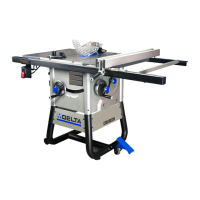5
. Read entire instruction manual before
operating saw. Learning the saw's proper applications, limitations, and specific potential hazards will greatly
minimize the possibility of accidents and injury. Make sure all users are familiar with its warnings and instructions
before using saw.
for instructions and warnings regarding power cords and
connections.
The following terms will be used throughout the manual and you should become familiar with them.
– Through-cut refers to any cut that completely cuts
through the workpiece.
– Non-through cut refers to any cut that does not
completely cut through the workpiece.
_ Push stick refers to a wooden or plastic stick, usually
homemade, that is used to push a small workpiece
through the saw and keeps the operator’s hands clear
of the blade.
– Kickback occurs when the saw blade binds in the cut
or between the blade and the fence and thrusts the
workpiece back toward the operator.
– Freehand refers to cutting without the use of a miter
gauge or rip fence or any other means of guiding or
holding the workpiece other than the operator’s hand.
– Plunge cutting refers to blind cuts in the workpiece
made by either raising the blade through the workpiece
or lowering the workpiece down to the blade.
– Re-sawing – Flipping material to make a cut the saw is
not capable of making in one pass.
– Cove cutting – Also known as coving, cove cutting is an
operation where the work is fed at an angle across the
blade.
Perform freehand cutting, plunge cutting,
resawing, or cove cutting.
, appropriate apparel,
hearing protection and dust protection as specified
in the General Power Tool Safety Section of this
manual.
. Your saw is equipped
with a modular blade guard, riving knife and
anti-kickback pawl assembly, each component
of which should be used for every possible
operation, including all through cuts. This
assembly is discussed in more detail below. Make
sure components are securely installed prior to
operation.
have any part of your
body in line with the path of the saw blade.
that is appropriate to the
application to push and hold down a workpiece
through the completion of the cut. A push stick is
a wooden or plastic stick, usually homemade, that
should be used whenever the size or shape of the
workpiece would cause you to place your hands
within 6 in. (152 mm) of the blade. Instructions for
making a push stick are included in this manual.
. Pay particular attention to
instructions (below) for reducing risk of kickback.
. Always use a rip fence,
miter gauge, or other appropriate devices to guide
or hold down the workpiece. Use hold-downs, jigs,
fixtures or feather boards to help guide and control
the workpiece. Accessories for use with your saw
are available at extra cost from your local dealer or
authorized service center.
. Never
reach over, in back of, or around the cutting tool
with either hand while the blade is in motion.
Make sure table saw is properly
assembled and located on a stable surface before
use to keep saw from moving during cut.
. Do not operate this saw until
it is completely assembled and installed according
to the instructions.
before
each operation. Knots, irregularities, or nails
in workpiece and positioning mistakes or
incomplete set-up may interfere with or affect saw
performance and personal safety.
. The proper throat
plate must be in place and properly secured at all
times to reduce the risk of a thrown workpiece and
possible injury.
for the
intended operation. The blade must be installed
so the points of the teeth are pointing toward the
front of the saw. Do not use oversized blade or
blade with incorrect arbor opening. Always tighten
the blade arbor nut securely. Before use, inspect
the blade for cracks or missing teeth. Do not use
a damaged or dull blade. Always use blade within
the thickness range for which the riving knife is
designed.
continued on page 6

